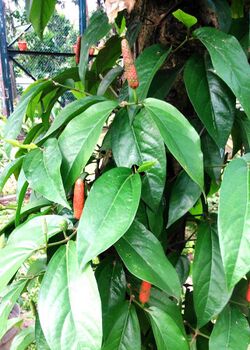Biology:Piper retrofractum
| Piper retrofractum | |
|---|---|

| |
| Scientific classification | |
| Kingdom: | Plantae |
| Clade: | Tracheophytes |
| Clade: | Angiosperms |
| Clade: | Magnoliids |
| Order: | Piperales |
| Family: | Piperaceae |
| Genus: | Piper |
| Species: | P. retrofractum
|
| Binomial name | |
| Piper retrofractum Vahl
| |
| Synonyms | |
|
Piper officinarum (Miq.) C.DC. | |
Piper retrofractum, the Balinese long pepper or Javanese long pepper, is a flowering vine in the family Piperaceae, cultivated for its fruit, which is usually dried and used as a spice and seasoning. This species is native to Java island in Indonesia.
Names
In Indonesia, the fruit was once known as cabai; however, its culinary popularity was superseded by the chilli, brought over from the New World by European traders, resulting in a semantic shift in which the new crop became cabai, and the old became cabai jawa.[1][2]
Botany
The plant is a climbing vine with stems of about 3–4 mm in diameter. Its leaves have blades that are glabrous, lanceolate, with acuminate apex and asymmetric base, and are about 10–12 cm long and 3–3.5 cm wide. The vine has been described as dioecious or monoecious,[3] with male spikes of about 5 cm long and female spikes about 4 cm long and 0.5–1 cm wide, and part of the ovaries are attached on the axis. Its berries are spherical and arranged densely on the axis.[4]
References
- ↑ Sherly Puspita (12 June 2019). "Mengenal Cabya, Nenek Moyang Cabai di Nusantara" (in id). Kompas. https://travel.kompas.com/read/2019/06/12/220900727/mengenal-cabya-nenek-moyang-cabai-di-nusantara.
- ↑
- "cabai jawa". cabai jawa (3rd ed.). Badan Pengembangan dan Pembinaan Bahasa, Kementerian Pendidikan dan Kebudayaan Republik Indonesia. 2016. https://kbbi.kemdikbud.go.id/entri/Cabai%20jawa.
- ↑ Chaveerach, Arunrat; Mokkamul, Piya; Sudmoon, Runglawan; Tanee, Tawatchai (2006-12-31). "Ethnobotany of the Genus Piper (Piperaceae) in Thailand" (in en). Ethnobotany Research and Applications 4: 223–231. doi:10.17348/era.4.0.223-231. ISSN 1547-3465. http://ethnobotanyjournal.org/index.php/era/article/view/116.
- ↑ Tanaka, Yoshitaka; Van Ke, Nguyen (2007). Edible Wild Plants of Vietnam: The Bountiful Garden. Thailand: Orchid Press. p. 113. ISBN 978-9745240896.
External links
| Wikimedia Commons has media related to Piper retrofractum. |
Wikidata ☰ Q7504329 entry
 |

